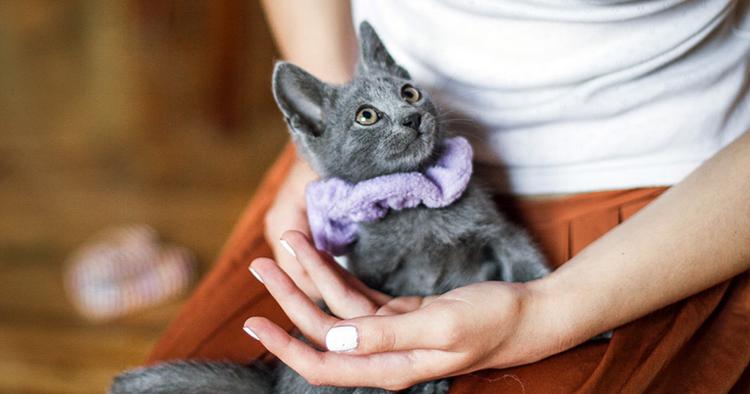Cats and Kids: Preparing for Cat Adoption
Are you ready to bring a new cat home? These tips will help you prep your kid for their new BFF.
Are you ready to bring a new cat home? These tips will help you prep your kid for their new BFF.
by Janelle Leeson, | March 5, 2024

PeopleImages / iStock
Growing up with a cat (or any pet!) is the best. While I can't recall my first time meeting a cat, I can wholeheartedly say that growing up with them shaped my life for the better. Now, as an expecting mom, I can't wait to introduce my cats to my baby. Registered clinical counselor Niloufar Esmaeilpour agrees: Caring for a pet teaches children empathy, responsibility, and compassion. Plus, they’re furry buddies who offer non-judgmental listening and emotional support when you need it after a sleepless night.
The key to a happy family lies in preparing kids for interactions with cats and ensuring smooth introductions. Parents can help their kids get ready for a new addition by teaching them basic cat care before your kitty ever arrives home. You’ll also want to create a calm and welcoming atmosphere for them.
If calm and kids in one sentence sounds too good to be true, we asked experts for their best cat-kid preparation tips.
Cats can be wonderful companions for babies, toddlers, or older children, but finding the right match is key. Spend time with different cats at shelters or rescue organizations to find one who clicks with your family and/or your child's personality, says Dr. Yui Shapard, veterinarian and educational director of the Association of Asian Veterinary Medical Professionals (AAVMP).
No two cats or even breeds of cats are created equal. While researching breeds and common temperaments beforehand is useful, cats are shaped by individual experiences just as much as their genetics.
But it's a two-way street! Before your little one meets any feline friend, make sure they understand how to respectfully interact with cats.
Even friendly cats can bite or scratch when they’re scared, stressed out, or when fingers and hands are used in play. “It’s important to explain to children that these kinds of interactions can happen because cats and humans don’t speak the same language,” suggests Dr. Laria Herod, an associate veterinarian at Banfield Hospital and veterinary advisor to Whisker.
How can you help prevent a cat bite or scratch? Give these steps a try:
Teach your child how to interact with cats: Encourage gentle pats, respecting the cat's space, avoiding touching the tail or belly, and letting the cat initiate interaction.
Provide a quiet room for your new cat: Gradually introduce your child to the cat in this space, setting the expectation that children should only enter the cat's room when accompanied by an adult until the cat is settled, suggests Joey Lusvardi, a certified cat behavior specialist and psychiatric physician assistant.
Use toys for play: “If you — or your children — play with your cats using your hands, your cat will think your body is a fun toy and will try to playfully nip at anyone in your home’s hands or feet,” Lusvardi says.
Unfortunately, cat bites and scratches can happen. If they do, first, thoroughly clean any punctures. Then, turn it into a learning moment, Lusvardi suggests. Calmly investigate with your child what might have triggered the cat's reaction by asking questions: “What were you doing when the cat scratched you?” ”What noises did you make that might have startled the cat?”
Avoid scaring or punishing your cat — don’t yell and don’t reach for the squirt bottle. “It’s very important,” Lusvadi says. This could make the cat more stressed out and they may even react with more aggression. Instead, focus on addressing the root cause of the behavior to prevent future incidents.
With a few simple routine changes and fun activities prepping for kitty, your kiddo will be all set to give your new cat a warm welcome home for a budding friendship.
Esmaeilpour suggests adding cat-themed books to your child’s library. Some great choices include:
100 Cats by Michael White is great for little ones. It’s full of rhymes and different-looking cats doing cat (and non-so-cat) things, like playfully pouncing on humans to wake them up and joyfully rubbing against their legs.
How to Be a Cat, Box Inspector and Other Important Jobs For Cats, and Be Hungry 24/7 And Other Secrets On Being Cat by Ralph Lazar and Lisa Swerling is a hilarious series that explores the antics of our feline friends.
Tails Are Not for Pulling by Elizabeth Verdick teaches the basics of kindness to animals.
Why Do Cats Meow by Lily Snowden-Fine. It’s a delightful book that answers the questions every cat lover is sure to ponder, accompanied by charming illustrations.
Allow your child to pick out toys and supplies for your new cat. After your cat arrives, talk with your kids about which ones your cat seems to enjoy the most. “You can then take them to pick out another toy or two for the cat to help them think about the cat’s preferences and improve their bond with the cat,” Lusvardi suggests.
If your child hasn't had much experience with pets before, learning how to pet, play, and use indoor voices around cats can take some getting used to. "Kids don’t develop something called theory of mind until they’re four or five," Lusvardi explains. This means they may struggle to understand that a cat has thoughts and intentions different from their own.
Depending on your child’s age, you can start by learning how to pet a cat using a stuffed animal. Eventually, you can visit a shelter. Lusvardi and Dr. Herod suggest trying out direct and positive affirmations, such as:
“Listen to how Fluffy is purring when you gently pet her head. She loves it when you do that.”
“If the cat’s tail is wagging, stop petting them.”
“Look at Socks chasing after that laser on the floor. You are having so much fun together.”
Rules and fun don't always go hand-in-hand, but when your children have a say in setting family rules, it can provide a sense of responsibility. For instance, pick out a feeding-station location together and set a rule that your cat will only eat in this location (bonus: it reduces the likelihood of your kiddo trying to slip your curious feline some crunchy veggies under the table). Then, divvy up age-appropriate tasks, like feeding the cat, brushing them, or scooping the litter box. Before bringing your cat home, you can have your kiddo even practice serving food or filling the water bowl.
Create your cat’s new space together. Little ones can help decide where the cat tree should go and what might be the cat’s favorite toys to keep in their special room. Get crafty, and help your kids make a sign for the cat's cardboard box or room door to show that it's their special quiet space. This can help your child understand and respect the cat's boundaries.
Dr. Herod admits that adding a new pet to the family is no easy task. “But it's a rewarding and wonderful experience.” Of course, your child's wellbeing is your first priority, so before bringing a cat home, ensure that there won't be any unexpected allergic reactions.
Because any animal can carry bacteria, go over self-care practices, like thoroughly washing hands after scooping the litter box or before eating if they've been playing with the cat. Most importantly, like everything else in life, your kids will be looking to you as an example of how to interact with pets, so do your best to stay calm, cool, and positive.
Here's a step-by-step guide for introducing a new kitten to your cat:
Keep them isolated initially.
Introduce them by scent swapping.
Gradually introduce them by sight with barriers.
Allow a face-to-face meeting under supervision.
Throughout each step, provide plenty of positive reinforcement for good interactions, whether it's treats, pets, or praise. Introductions may take days or even weeks, so be patient and avoid rushing the process.
“Children have so much to gain from having pets,” Dr. Herod says. They can improve children's social interactions and even boost their self-esteem. She adds: “Children growing up with pets have a unique exposure to life lessons and learn how to navigate those, including the tough ones like sickness and mortality.”

Janelle Leeson is a Portland, Oregon-based freelance writer. Her work has been featured in magazines such as Inside Your Dog’s Mind, Inside Your Cat’s Mind, and Paw Print, as well online at Insider Reviews, NBC Select, Shop Today, PetMD, and Daily Paws. She has two adventure cats, a flock of urban chickens, and a soon-to-be-husband who doesn’t mind housing the occasional foster cat — or five.

Breed Info

Adoption Advice

Adoption Advice

Adoption Advice
Are you bringing home a new kitten? Find out the best way to introduce your new kitten to your crew.

Adoption Advice
Thinking of adopting a dog with kids? Read more to learn about the benefits pets can have on children.